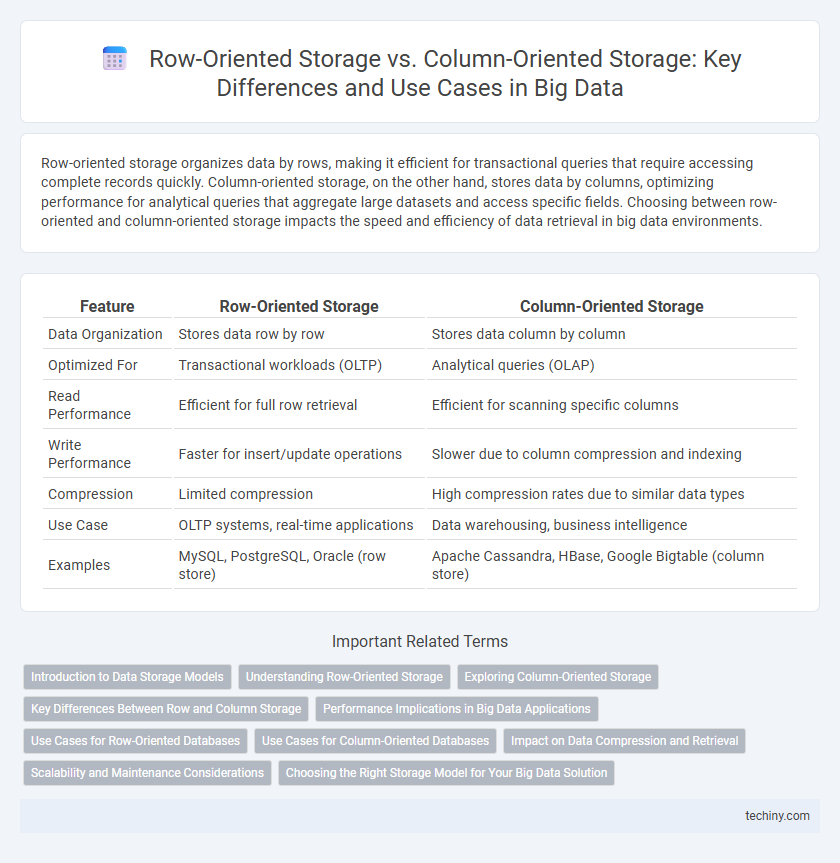Row-oriented storage organizes data by rows, making it efficient for transactional queries that require accessing complete records quickly. Column-oriented storage, on the other hand, stores data by columns, optimizing performance for analytical queries that aggregate large datasets and access specific fields. Choosing between row-oriented and column-oriented storage impacts the speed and efficiency of data retrieval in big data environments.
Table of Comparison
| Feature | Row-Oriented Storage | Column-Oriented Storage |
|---|---|---|
| Data Organization | Stores data row by row | Stores data column by column |
| Optimized For | Transactional workloads (OLTP) | Analytical queries (OLAP) |
| Read Performance | Efficient for full row retrieval | Efficient for scanning specific columns |
| Write Performance | Faster for insert/update operations | Slower due to column compression and indexing |
| Compression | Limited compression | High compression rates due to similar data types |
| Use Case | OLTP systems, real-time applications | Data warehousing, business intelligence |
| Examples | MySQL, PostgreSQL, Oracle (row store) | Apache Cassandra, HBase, Google Bigtable (column store) |
Introduction to Data Storage Models
Row-oriented storage organizes data by rows, allowing efficient transactional processing and quick access to complete records, ideal for Online Transaction Processing (OLTP) systems. Column-oriented storage structures data by columns, optimizing analytical queries by enabling fast aggregation and compression, commonly used in Online Analytical Processing (OLAP) environments. Choosing between these models depends on workload requirements, with row-oriented suited for frequent writes and updates, while column-oriented supports read-heavy queries on large datasets.
Understanding Row-Oriented Storage
Row-oriented storage organizes data by storing all fields of a single record together, allowing for quick access and efficient transaction processing in operational databases. This storage format excels in scenarios involving frequent reads and writes of entire rows, such as online transaction processing (OLTP) systems. Due to its design, row-oriented storage is less efficient for analytical queries that aggregate data across columns but is optimal for workloads requiring fast insert, update, and delete operations.
Exploring Column-Oriented Storage
Column-oriented storage optimizes big data analytics by storing data tables by columns rather than rows, enhancing query performance for read-intensive operations. This storage model significantly reduces I/O by accessing only relevant columns, making it ideal for aggregation, filtering, and compression in data warehouses. Technologies like Apache Parquet and Apache ORC leverage columnar storage to improve scalability and enable faster processing of large-scale datasets.
Key Differences Between Row and Column Storage
Row-oriented storage organizes data by rows, making it efficient for transaction processing and scenarios requiring quick access to entire records. Column-oriented storage stores data by columns, optimizing analytical queries and aggregations by reading only relevant columns, improving I/O and compression. Key differences include performance in query types, storage efficiency, and suitability for OLTP versus OLAP workloads.
Performance Implications in Big Data Applications
Row-oriented storage efficiently handles transactional workloads by storing complete records together, enabling faster write operations and quick retrieval of individual rows in Big Data environments. Column-oriented storage excels in analytical queries by storing data column-wise, allowing high compression rates and rapid access to specific attributes, significantly speeding up aggregation and scanning tasks. Performance in Big Data applications depends on workload type, with row-oriented storage favoring OLTP systems while column-oriented storage optimizes OLAP and large-scale analytics.
Use Cases for Row-Oriented Databases
Row-oriented storage excels in transactional systems where quick insert, update, and delete operations on individual records are critical, such as in banking, e-commerce, and CRM applications. It optimizes performance for workloads with frequent access to entire rows, making it ideal for OLTP (Online Transaction Processing) systems that require fast, real-time data manipulation. This storage model supports complex queries involving multiple columns of the same row efficiently, enhancing response times in high-concurrency environments.
Use Cases for Column-Oriented Databases
Column-oriented databases excel in analytical workloads, enabling fast aggregation and querying over large datasets typical in business intelligence and data warehousing environments. They optimize performance for read-intensive operations by storing data in columns, which enhances compression and speeds up retrieval of specific attributes across massive records. Use cases include real-time analytics, trend analysis, and complex ad hoc queries where scanning large volumes of data is required efficiently.
Impact on Data Compression and Retrieval
Row-oriented storage stores data by rows, enabling faster writing and retrieval of complete records but often resulting in lower data compression due to less redundancy within rows. Column-oriented storage organizes data by columns, significantly improving compression rates by exploiting similarities in columnar data and accelerating analytical queries through efficient column-wise retrieval. This architectural difference impacts query performance and storage efficiency, making column-oriented storage preferable for read-intensive big data analytics workloads.
Scalability and Maintenance Considerations
Row-oriented storage excels in transactional workloads by efficiently handling write operations and maintaining data consistency, making it suitable for high-volume, real-time data ingestion and ensuring straightforward scalability through horizontal partitioning. Column-oriented storage optimizes read performance for analytical queries by storing data column-wise, which reduces I/O and improves compression, but it requires more complex maintenance practices such as frequent column reorganization and may face challenges with write scalability due to batch-oriented data loading. Balancing scalability and maintenance involves choosing row storage for dynamic, write-heavy environments and column storage for large-scale analytics where read efficiency and storage optimization are critical.
Choosing the Right Storage Model for Your Big Data Solution
Row-oriented storage excels in transactional systems where quick write operations and entire row retrievals dominate, making it suitable for OLTP workloads. Column-oriented storage optimizes read-heavy analytical queries by storing data column-wise, enabling efficient compression and faster aggregation in OLAP environments. Selecting the right storage model hinges on workload type, data access patterns, and performance needs to balance speed, storage efficiency, and query complexity in big data solutions.
Row-Oriented Storage vs Column-Oriented Storage Infographic

 techiny.com
techiny.com